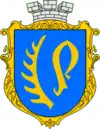Rohatyn
Rohatyn (Russian: Рогатин, Ukrainian: Рогатин, Polish: Rohatyn, Yiddish: ראהאטין) is a city located on the Hnyla Lypa River in Ivano-Frankivsk Oblast, in western Ukraine. It is the administrative center of Rohatyn Raion (district). Population: 7,716 (2020 est.)[1] .
Rohatyn
Рогатин Rohatyn | |
|---|---|
 Statue of Nastia Lisovska[lower-alpha 2] (Hürrem Sultan) in downtown Rohatyn | |
 Flag  Coat of arms | |
 Rohatyn Location of Rohatyn within Ukraine  Rohatyn Rohatyn (Ukraine) | |
| Coordinates: 49°25′N 24°37′E | |
| Country | |
| Oblast | |
| Raion | Rohatyn Raion |
| Founded | 12th century |
| Population (2020) | |
| • Total | 7,716 |
| Website | www.rohatyn.ronet.com.ua |

Prior to World War II the town was located in Poland.
Name
It was first mentioned in historical documents in 1184 as a part of the Kingdom of Galicia–Volhynia. Its name seems to be derived from Ruthenia, the name of the region of the location. However, the town emblem has a horn of a deer which gives the first part of the Slavic name of Rohatyn or Rogatyn – "Rog" ("Horn"). The second part "Tyn" can be connected with a word which means "Stacket". Together these two words give us "Horn Stacket".
Also, there is a legend connected with the image of the deer horn of the town emblem. It is said that a wife of the Duke Jaroslav Osmomysl, being lost in a forest, met a deer. She survived by following the deer out of the forest. A fort was built with name "Rogach" ("Deer") on the place where the duchess supposedly stepped out of the forest.
The town name also can be connected with the Slavic word "Rogatyna" which means a heavy spear for martial arts or bear hunting ("Bear Spear"). It was first mentioned in 1149 (Laurentian Chronicle). In Polish heraldry "Rogacina" means "Broadhead".
History
In 1415, under Polish rule, it was granted Magdeburg rights, and subsequently developed into an important trading and manufacturing town. In 1520, the region was attacked by Crimean Tatars, Hürrem Sultan, a native of Rohatyn, was captured there and sold to the Ottoman Sultan Suleiman the Magnificent of which she became his concubine, then his legal wife and haseki sultan. In the 16th century a renowned school of icon painting arose in Rohatyn, and in the 1580s an Orthodox brotherhood was founded obtaining the stauropegion (a monastery exempt from the control of the local bishop) status. After the First Partition of Poland in 1772, Rohatyn was annexed by Austria, and became a county center. A Ukrainian gymnasium was established there in 1909, and a minor theological seminary in 1931. In 1910, half of the town population was Jewish. During the interwar period the town was under Polish rule. In 1939, it became part of Soviet Ukraine and was granted city status. During World War II, 99 percent of the 3,000 strong Jewish population were murdered in The Holocaust.
Today it is an important highway junction; 26 percent of its inhabitants work in the transportation industry.
Monuments
- stone Church of the Nativity of the Theotokos (end of the 14th century)
- remnants of the town walls and gate from the 13th and 14th centuries
- wooden Church of the Holy Spirit (1644–1645) with a magnificent iconostasis (1647–1650) is on UNESCO world heritage list
- the ruins of the Dominican monastery (1614)
- Roman Catholic Saint Nicholas's Church in the Renaissance style (1666)
- wooden Saint Nicholas's Church (1729).
People
- Hürrem Sultan (Roxelana), consort to Suleiman the Magnificent, Haseki Sultan of the Ottoman Empire
- Lessia Leskiv, a Ukrainian sport shooter
- Ivan Krypiakevych, a Ukrainian historian, academician, professor of Lviv University and director of the Institute of Social Sciences of Ukraine, worked in Rohatyn.
Gallery
 A street in Rohatyn
A street in Rohatyn Nativity of Blessed Virgin Mary Ukrainian Catholic Church
Nativity of Blessed Virgin Mary Ukrainian Catholic Church.jpg.webp) Holy Spirit church
Holy Spirit church Catholic Saint Nicholas's Church
Catholic Saint Nicholas's Church Church of Saint Nicholas
Church of Saint Nicholas.jpg.webp) Jewish musicians from Rohatyn, 1912
Jewish musicians from Rohatyn, 1912
Location
- Local orientation
- Regional orientation
Notes

- As inscribed on the monument
- As inscribed on the monument
References
- "Чисельність наявного населення України (Actual population of Ukraine)" (PDF) (in Ukrainian). State Statistics Service of Ukraine. Retrieved 30 September 2020.
External links
| Wikimedia Commons has media related to Rohatyn. |